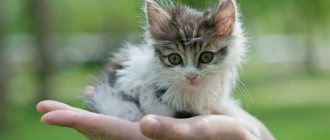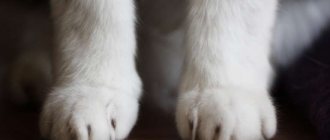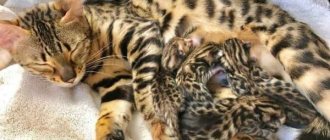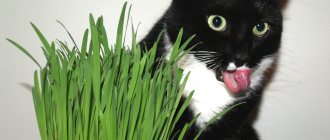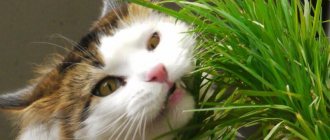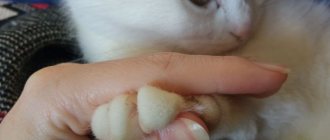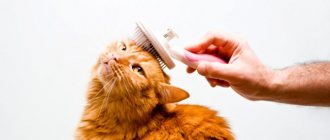Perhaps you will need grass for cats if your pet has ever bitten flowers. The fact is that cats simply need to eat green sprouts, just like people need to eat salads.
If your cat goes outside, you've probably noticed her chewing on different blades of grass from time to time. This is a harmless action - thereby it determines what can be eaten and what is harmful or even dangerous to health. But animals that don't go outside have no way of finding the grass they need. They begin to eat house plants and can harm themselves. Petunias, hydrangeas, lilies, orchids, ficuses and other house plants cause poisoning, swelling and allergies in the animal. Do not punish your pet for damaging your flowers, but offer him healthy grass for cats that you can grow yourself, decorating your apartment and making your pet happy.
Why do cats eat grass?
The herb is a laxative. Our furry pets often suffer from digestive disorders and slow bowel movements.
- The reason for this is the accidental entry into the digestive tract of elements that are not fully digested.
- Wild cats, for example, while eating prey, be it a mouse or a bird, absorb meat along with hair or feathers, which leads to constipation and complications in digestion.
Domestic cats are also not immune from foreign elements entering the body, such as their own hair when washing and other debris.
Substances contained in herbaceous plants can cause irritation in the digestive tract, which subsequently leads to easy bowel movements and restoration of stable digestive function.
Are herbs always beneficial?
Cats living in nature or on the street usually instinctively choose the right herbs for medicinal or cleansing purposes. Pets do not have this experience, and their instincts are most often somewhat muted. There is a high risk for them to chew grass that is hazardous to their health while walking.
Even a plant that is safe in its composition can cause considerable harm if it grows in a polluted area - on roadsides or near industrial enterprises. In addition, there is no guarantee that this grass is not contaminated with helminth eggs or contaminated by the feces of a sick animal.
Not all outdoor grass is good for your pet.
If the animal does not leave the house and does not receive the necessary greenery in the required quantities, then it may well switch to nibbling indoor plants, some of which may be very poisonous. As a result - various troubles, even death, and specifically the following side effects:
- uncontrollable vomiting;
- digestive disorders;
- pain and cramps;
- renal, heart or pulmonary failure.
Common houseplants can cause serious harm to a cat.
Here are some houseplants to keep out of your cat's reach:
- amaralis;
- asparagus;
- geranium;
- dieffenbachia;
- caladium;
- lily of the valley;
- spurge;
- narcissus;
- oleander;
- ivy;
- spathiphyllum;
- physalis;
- ficus;
- philodendron;
- Cyperus;
- cyclamen.
Offer your pet only safe green treats.
Video: which plants can be dangerous for a cat
Vitamins for cats
A cat’s diet directly affects the condition of its coat, skin and claws, well-being and motor activity. Despite the carnivorous nature of cats, the diet should not consist only of meat products containing animal fats and proteins.
Animals, even the most predatory ones, like any organism, need fiber and certain vitamins, amino acids, micro- and macroelements, which are found in abundance only in plant foods.
Blades of grass contain folic acid in their juice, which is important for the growth and development of the animal, so it is especially important to provide the cat with access to grass during the period of gestation.
How to grow cat grass at home
You can purchase a ready-made miniature lawn for your mustachioed pet at almost every pet store. These are relatively small financial costs. But a cat is an unpredictable creature, and may refuse a green gift if it doesn’t like something. Try providing your pet with a vitamin supplement by building a garden bed right on the windowsill.
Seed selection
Large grains of cereal crops are convenient for sowing grass indoors. They are usually sold already packaged in packages of 10–100 grams. The most popular is oats, but some producers include wheat and barley in the harvest for sowing.
To grow shoots of field grasses, you need to collect their seeds yourself at the end of summer. Ready-made lawn grain mixtures are treated with growth stimulants and fertilizers, so they should not be given to cats . In addition, such plants germinate and develop poorly in winter, when the length of daylight hours is reduced.
Criteria for purchasing seed:
- Buy from a reliable supplier who values its reputation. Otherwise, you risk getting a bag of old grain. Due to low germination, there will be few sprouts. Look at the expiration date indicated on the packaging.
- Ask the seller if the seeds have been treated with chemicals, and also check for fungal infection.
- Decide how many grains you want to plant. It depends on the size of the future lawn. If its dimensions are 20x20 cm, then you will need 30–40 grams of seeds. The same amount is enough for sowing in a seedling tray measuring 38x16 cm. It’s not worth buying more if you have one container occupied.
Planting grass
Before you start growing green food for your cat, you need to prepare a flat dish. Transparent cookie packaging or disposable plates made of food-grade plastic are suitable for this purpose. The height of the sides should not exceed 8 cm. To plant grass, take two containers. Holes are made in the bottom of one of them to drain excess water and placed in the other. It is not advisable to use a flower pot on a stand - the cat will easily knock it over when it starts pulling out the stems.
To secure roots, oat seedlings need any substrate. mixtures for indoor flowers are used as soil . Earth brought from the street is disinfected by heating it at a temperature of +650C to destroy the plant diseases it contains. But you shouldn't plant grass in the soil if your cat likes to dig in it. Then the lush greens and the contents of the mini-garden will be scattered on the floor.
The grains of cultivated cereals contain a supply of nutrients necessary for growth. To get healthy shoots in containers without soil, use any natural material as a substitute. A paper towel, a package of napkins or cotton pads will do. They are environmentally friendly and will not cause harm to your pet’s health if he accidentally eats them. To maintain air access to the surface of the seeds, gauze with a sparse weave of threads is used.
Cereals grow without soil, using nutrition from their own seeds.
Sowing stages:
- To create a “vegetable garden” on the windowsill, choose at least three days in a row of sunny weather to provide the sprouts with more light and warmth.
- The seeds are poured into a glass jar and filled with water for an hour. The floating waste is removed with a spoon. The full grains remaining at the bottom are placed on a napkin.
- In the prepared container, the soil substrate is compacted with a layer of 1.5–2.0 cm, and seeds are placed thickly on top. Level with a spoon. Sprinkle them with a small amount of soil and compact them slightly.
- When sowing without soil, place a layer of cotton wool or paper up to 1 cm thick at the bottom of the container, then wet grains of oats or wheat. They are covered with gauze folded in half.
- Water it with water heated to +250C to stimulate the awakening of the grains. It is advisable not to over-wet the future lawn, otherwise mold will appear.
- Cover the top with plastic wrap or place it in a transparent bag and tie it at the side. Leave a little free space for the sprouts to breathe. Place the dishes in a warm place, closer to the radiator.
Growing
To obtain successful shoots, it is necessary to maintain a room temperature of at least +200C and a humidity of the root zone of 75%. In November and December, the days are very short, so the tray with oats needs additional lighting. To prevent plants without soil from starting to rot and acquiring an unpleasant odor, they are thoroughly washed every day with running water.
Features of growth:
- 48 hours after planting, oats begin to take root. The film is removed and the surface of the soil or gauze is sprayed with water in the morning and evening. A day later, the first light yellow shoots appear. The box is placed on the window under the sun's rays.
- Each plant produces a pair of true leaves. They acquire a green tint already on the fifth day. Water them in the morning and evening so that the roots do not dry out. A hard, thick carpet of seedlings is formed, which bend towards the light. The tray is turned to the window with different sides so that the stems develop evenly.
- The roots of the oats grow and intertwine together, forming a dense lump.
- Less than a week has passed, and the blades of grass have already reached a height of 8–12 cm. Their upper ends are unfolded and contain a maximum of vitamins. It's time to offer your pet treats.
Plant foods help domestic cats clear their stomachs of hair.
Growing green food for your mustachioed pet without using soil is the most convenient option for owners living in apartment buildings. This method allows you to provide the animal with plant food at any time of the year.
Anti-diarrhea remedy
Some types of herbs, in particular those with dense and narrow stems, have a strengthening effect on the digestive tract.
Animals often instinctively sense the slightest changes in their body that bring discomfort, and immediately look for an opportunity to restore health.
Herbaceous plants always come to the rescue if the animal has access to them.
To cleanse the stomach
Cats are natural hunters. Being free-range, they mainly feed on mice and birds. During lunch, not only meat enters the stomach, but also feathers and skin - it is difficult to digest all this. In addition, such “waste” has no nutritional value. Also, small bones can get into the intestines, which are dangerous to health. When a cat “eats” a rodent on grass, it causes irritation of the stomach walls and, as a result, regurgitation.
Thus, the cat cleanses the gastrointestinal tract. But not only street bandits feast on grass, but also purely urban meowing individuals who have never even tried to catch prey. What's the matter? Cats love cleanliness - licking their own fur coats.
During this process, pets swallow hairs, which then fall into the hair ball. A dense ball, a bezoar, can cause ulcers or bleeding, intestinal blockage and death of the animal. By eating grass, the cat helps itself get rid of hairs before they form a bezoar.
Types of Herbaceous Plants for Cats
What kind of grass do cats eat and what effect does each type of grass have on the animal’s body?
- Fresh wheat. It is believed that the most favorite grass of cats is wheat. At the same time, cats often prefer freshly sprouted wheat. Fresh wheat tastes sweet, is soft to eat and contains a record amount of nutrients compared to less fresh wheat.
- Wheat is easy to grow, unpretentious and does not require intensive care, while it germinates quite quickly.
- Barley is rich in folic acid, which is extremely important for the proper growth and development of your pet. In addition, barley has a positive effect on the digestive tract and can significantly speed up metabolism. This herb can also restore the strength lost after physical activity to your pet.
- Thyme. This spicy and medicinal plant has an excellent effect on the pet’s nervous system in such a way that it reduces stress, removes anxiety and calms. After eating thyme, the pet becomes affectionate and gentle.
- Wheatgrass is a weed, so many people are not even aware of its beneficial properties for furry pets. Wheatgrass contains a large amount of minerals and vitamins A, B and E. Thanks to the tough leaves of wheatgrass, the cat's stomach is well cleansed, and digestion is immediately normalized.
- Licorice. This type of herb can prevent allergies and heal irritated mucous membranes. Licorice also has a beneficial effect on digestion.
What greens do they prefer?
In the wild, cats prefer to eat wheatgrass. This is a thin and inconspicuous herb that grows almost everywhere. The pet does not have access to this vegetation, since the street is often closed to it. Therefore, the following vegetation can be offered as an alternative:
- sprouted oats (“cat grass”). It is not difficult to grow such grass. Cultivation involves planting seeds in the ground and periodically watering;
- barley and wheat. These plants are analogues of oats. They are also easy to grow on a windowsill. However, not all pets will like this replacement;
- nettle. Typically, cats like such burning vegetation when they are in a lactating state and feeding kittens. However, this option is not designed for everyday use;
- parsley. This plant is preferred by animals that have kidney problems. Parsley is an excellent diuretic. It also acts as a sedative on the nervous and digestive systems;
- other useful herbs. For example, it could be catnip. The mint aroma from the plantings will not only attract your pet, but will also help to some extent remove unpleasant odors from the room.
This is not a complete list of plants that can be grown in an apartment. It is difficult to immediately understand which grass a cat will prefer. Therefore, you will have to plant seedlings more than once. Offer your animal different options and you will learn his favorite type of weed.
You can buy seeds for germination at any zoological store. You can also buy regular oats. It is easy to germinate, but will be cheaper with the same effectiveness.
Herbs that are contraindicated for cats
When it comes to which grasses should not be given to cats, there is often controversy.
- Catnip is a low-growing plant that is very attractive to cats.
- Many cat lovers believe that catnip is essential for their pets because it reduces stress levels.
- There is an opinion that this spicy plant is like wine for humans.
- Just as people can relax with a glass of their favorite semi-sweet drink, cats can relax after eating this miracle herb.
- In fact, catnip and valerian are completely contraindicated for furry pets in large quantities.
- These plants have a narcotic effect and are addictive.
One-time consumption can be allowed, but it is under no circumstances worth growing them for regular consumption.
The cat will not refuse: useful vegetation
The most useful plants that the animal will like:
- Cereals . Oats, wheat, and barley are very good at clearing the stomach of swallowed wool . They saturate the body with vitamins and microelements.
- meadow grasses do a good job of cleaning the stomach - bluegrass, sedge, timothy, wheatgrass . For animals that do not go for walks, you can bring a vitamin bundle from the street.
- Valerian. The calming effect of this plant is widely known. Valerian has a different effect on the cat family. Even lazy couch potatoes become active and mobile, like kittens. They simply go crazy from the smell of leaves, lilac flowers and rhizomes of valerian. The use of the plant is allowed for medicinal purposes. Valerian is indicated for thyroid dysfunction, intestinal spasms, and muscle atony. But it should not be added to the diet. Eating valerian can lead to addiction.
The aroma of the plant will help accustom your pet to the tray or scratching post.
- Catnip (catnip). Aromatic herb, cats don’t breathe smoothly towards it. It has a similar, but milder effect. Used similarly to valerian. You can sew a little dry mint inside the toy. The animal will happily “hunt” fragrant prey and frolic.
- Chamomile. The wildflower is safe for domestic predators. Chamomile infusion is used for medicinal purposes. It is used to wash the eyes for conjunctivitis. Externally applied for dermatological problems. Chamomile will help with poisoning.
- Peppermint and lemon balm . You can offer your pet mint and lemon balm. But not all cats eat them.
- Parsley and dill. Usually, cat owners do not refuse greens. Therefore, you can give your pet a bunch of parsley or dill.
- Carrot tops. They love fluffies and carrot tails . The tops are rich in calcium, iodine, selenium, vitamin C and group B.
- Licorice. Useful medicinal plant for animals. Licorice roots are used for respiratory diseases. Veterinarians recommend licorice to treat arthritis in cats. It has an antihistamine effect.
- Marigold. Flowers with a specific aroma are often eaten by animals. The leaves and flowers of marigolds contain essential oils, ascorbic acid, rutin, and lutein. Dried marigolds are contained in some commercially produced feeds.
- Chlorophytum. A houseplant whose soft, juicy greenery is very popular with cats. Safe for pets. The owner will have to work hard to find a place for a pot of chlorophytum. Otherwise, the cat will gnaw off all the foliage of the plant.
- Thyme (thyme). This inconspicuous grass with an alluring aroma attracts cats. Thyme helps solve digestive problems. Has an anthelmintic effect.
- Pyrethrum maiden (matricaria, chamomile maiden). This plant with small flowers in dried form is added to the pet’s food. Used for gastrointestinal problems.
- Dandelion. The roots of the bright flower are given to pets. Dandelion normalizes liver function and helps strengthen the immune system.
- Plantain. Improves the process of peristalsis. Has a slight hemostatic effect. When a cat does not share the territory with a neighbor and returns with scratches, plantain is suitable for first aid.
- Nettle. The plant is a storehouse of vitamins and minerals. Before putting the leaves in a bowl, they are scalded with boiling water or boiled briefly. Nettle improves lactation in a nursing mother.
Algorithm for growing herbaceous plants for cats
There are many ways to grow grass for cats. The main and most affordable way is to grow grass in the ground.
First, you need to purchase quality seeds at a pharmacy or pet store. It is important that they are not treated with fertilizers and chemicals. Nowadays, every animal store has a full range of planting material of various types, so there will be no difficulties in finding seeds.
When the seeds are purchased, you need to think about the choice of soil. Before planting, the seeds are soaked for a day in warm water, adding a pinch of soda. Moistened seeds are sown in the soil and sprinkled with soil on top. For accelerated growth and rapid germination, containers with soil are covered with cling film, which creates a greenhouse effect.
- As a rule, the first shoots appear already on the 3rd or 4th day.
- As soon as the shoots appear, the film must be removed.
- Then the grass grows under normal conditions.
The only care during this period is timely moistening of the soil. After 6-7 days, the grass will finally germinate and be ready for use.
Mr. Cat recommends: what to do if your cat likes to eat grass?
You should not interfere with your pet’s desire to chew vegetation. Of course, it is necessary to remove indoor flowers from the access zone; many of them can be poisonous and dangerous for the cat.
Instead, you can purchase special mixtures for germination or ready-made pots of herbs in the store. Most often, cereal sprouts are used as vitamin treats: barley, oats, wheat. You need to understand that cats' tastes may differ.
Some pets prefer to chew on a piece of cucumber or fresh pumpkin seeds. It is important to offer your animal several different options.
